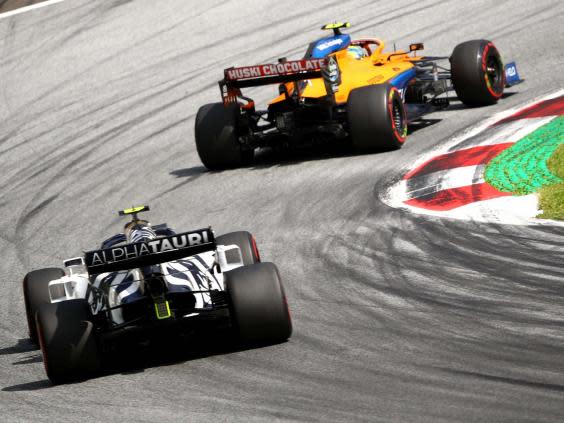What have we learned from F1’s first double-header in Austria? Mercedes dominance, Ferrari struggles and McLaren reborn

Formula One’s brave gamble to stage back-to-back races in Austria paid off handsomely, with two exhilarating Grands Prix in the bag and, crucially, not a single positive coronavirus test to show for their efforts.
The fear over F1’s return lay rooted in the cross-border travel required for teams and drivers to be at each race, and while it would be foolish to break out the bunting just yet with the paddock setting off on the 420km drive east to the Hungaroring, no positive test results is certainly a step in the right direction.
There were hiccups along the way. Ferrari were twice warned under the sport’s new Covid-19 Code, firstly after Sebastian Vettel was spotted not adhering to social distancing as he spoke with Red Bull’s Christian Horner and Helmut Marko without face masks, and secondly when Charles Leclerc broke out of his ‘bio-bubble’ to return home to Monaco and see friends. Another breach will see much harsher punishments handed out, though that is the least of Ferrari’s concerns right now.
Unquestionably, it is the Prancing Horse that has the most to think about on the drive to Hungary. Leclerc’s second-place finish in the curtain-raiser masked over the gaping cracks that have emerged in this season’s car, although any improvement from the upgrades brought to the second race could not be measured thanks to Leclerc’s rash first-lap decision to squeeze three into two and take both himself and Vettel out of the Styrian Grand Prix.
Five days is unlikely to result in a dramatic change in fortunes, although the short-track nature of the Hungaroring should at least limit the power difference that Mercedes, Renault and Honda enjoyed over Ferrari in Austria.
However, we truly do not know where these cars are just yet because of the nature of this year’s championship. The V6 turbo-hybrid era has shown us that each track favours different cars in different ways, so having two races at the same circuit in largely similar conditions has told us little.
What we do know though is that for Mercedes to leave with two wins from two at a circuit that has favoured Red Bull heavily in recent years is a sign of how strong the reigning champions are. Hungary could well prove to be Red Bull’s last hope of doing damage on the German manufacturer for quite some time, as with the fast tracks of Silverstone, Barcelona, Spa and Monza to follow, Mercedes will need no second invitation to flex their superior power unit. Even at Sochi and Mugello, the enormous straights at both circuits will play into the hands of Lewis Hamilton and Valtteri Bottas.
As nice as it would be to see a genuine two-team championship battle unfold, 2020 does not look the year for it unless the chasing pack can find something new.
It may come to be that a season similar to 2014, 2015 and 2016 plays out when the intra-team battle takes on a far greater importance with the world championship on the line. Valtteri Bottas has not really come close to ending Lewis Hamilton’s domination of the sport since replacing Nico Rosberg, and despite hinting at doing exactly that by winning the Austrian Grand Prix, Sunday’s event was something of an eye-opener.

Bottas was already on the back foot after qualifying, with the Finn only managing fourth as Hamilton turned in one of the greatest wet-weather laps F1 has ever seen, and his race display was not quite on the same level as his British teammate either. Much more will be needed if he is to maintain his lead in the championship standings come the end of the season.
The midfield battle behind them will rest hugely on this week’s events - and by that I mean the decisions made off the track. Racing Point will be kicking themselves with how they managed to be beaten by McLaren two weeks in a row, but more concerning will be the protest lodged by Renault that will be heard ahead of next weekend’s event. With Mercedes ordered to bring their 2019 brake ducts for inspection, the stewards know exactly what they need to be looking at, and although Racing Point are adamant they have followed the letter of the law, there is no getting away from the fact that their car is based around a similar design to the one that took Hamilton to world title No 6. Is it exactly the same to an illegal degree? There won’t be much sleep at Racing Point this week until the final verdict is delivered.
But perhaps the most impressive lesson to come out of the opening double-header is ‘last lap Lando’. In a similar way to playing to the whistle, Lando Norris has made a point of racing to the chequered flag. It has paid off with two handsome results for McLaren, given that across the last lap of both races he has transformed fifth into third, seventh into fifth and 16 points into 26. This year’s McLaren doesn’t appear to be the third-best car on outright pace this season, with Mercedes, Red Bull and Racing Point in front, but through race craft and outright talent they head to Hungary second in the constructors’ championship and with Norris third in the drivers’ championship. Who’d have thought that two weeks ago?

With Renault showing signs yesterday that they can join that battle if they can resolve their reliability issues, the mid-field fight could well prove to be the key feature of this season.
However, while it will undoubtedly be entertaining to watch play out, that may be the sad indication that this year’s championship battle is already a one-team affair.

 Yahoo News
Yahoo News 
